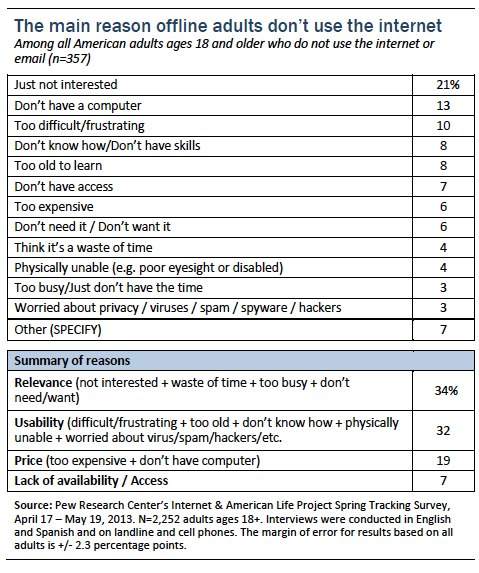- MENU
- HOME
- SEARCH
- WORLD
- MAIN
- AFRICA
- ASIA
- BALKANS
- EUROPE
- LATIN AMERICA
- MIDDLE EAST
- United Kingdom
- United States
- Argentina
- Australia
- Austria
- Benelux
- Brazil
- Canada
- China
- France
- Germany
- Greece
- Hungary
- India
- Indonesia
- Ireland
- Israel
- Italy
- Japan
- Korea
- Mexico
- New Zealand
- Pakistan
- Philippines
- Poland
- Russia
- South Africa
- Spain
- Taiwan
- Turkey
- USA
- BUSINESS
- WEALTH
- STOCKS
- TECH
- HEALTH
- LIFESTYLE
- ENTERTAINMENT
- SPORTS
- RSS
- iHaveNet.com: Technology
by Kathryn Zickuhr

Who's Not Online and Why
15% of American adults do not use the internet at all, and another 9% of adults use the internet but not at home
As of May 2013, 15% of American adults ages 18 and older do not use the internet or email. Asked why they do not use the internet:
- 34% of non-internet users think the internet is just not relevant to them, saying they are not interested, do not want to use it, or have no need for it.
- 32% of non-internet users cite reasons tied to their sense that the internet is not very easy to use. These non-users say it is difficult or frustrating to go online, they are physically unable, or they are worried about other issues such as spam, spyware, and hackers. This figure is considerably higher than in earlier surveys.
- 19% of non-internet users cite the expense of owning a computer or paying for an internet connection.
- 7% of non-users cited a physical lack of availability or access to the internet.

As in previous surveys by the Pew Research Center's Internet Project, internet use remains strongly correlated with age, educational attainment, and household income. One of the strongest patterns in the data on internet use is by age group: 44% of Americans ages 65 and older do not use the internet, and these older Americans make up almost half (49%) of non-internet users overall.
Though they themselves do not go online, these self-described non-internet users often report that the internet touches their lives:
- 44% of offline adults have asked a friend or family member to look something up or complete a task on the internet for them.
- 23% of offline adults live in a household where someone else uses the internet at home, a proportion that has remained relatively steady for over a decade.
- 14% of offline adults say that they once used to use the internet, but have since stopped for some reason.
Overall, most adults who do not use the internet or email do not express a strong desire to go online in the future: just 8% of offline adults say they would like to start using the internet or email, while 92% say they are not interested. We also offline adults whether they would need assistance going online if they did wish to do so, and found that only 17% of all non-internet users say they would be able to start using the internet on their own, while 63% say they would need assistance.
Even among the 85% of adults who do go online, experiences connecting to the internet may vary widely. For instance, while 76% of adults use the internet at home, 9% of adults use the internet but lack home access. Groups that are significantly more likely to rely on internet access outside the home include blacks and Hispanics, as well as adults at lower levels of income and education. Finally, while most home internet users have broadband in some form, 3% of all adults go online at home via dial-up connections.1
About this survey
The findings in this report are based on data from telephone interviews conducted by Princeton Survey Research Associates International from April 17 to May 19, 2013, among a sample of 2,252 adults ages 18 and older. Telephone interviews were conducted in English and Spanish by landline and cell phone. For results based on the total sample, one can say with 95% confidence that the error attributable to sampling is plus or minus 2.3 percentage points. More information is available in the Methods section at the end of this report.
Article: Pew Research Center's Internet Project.